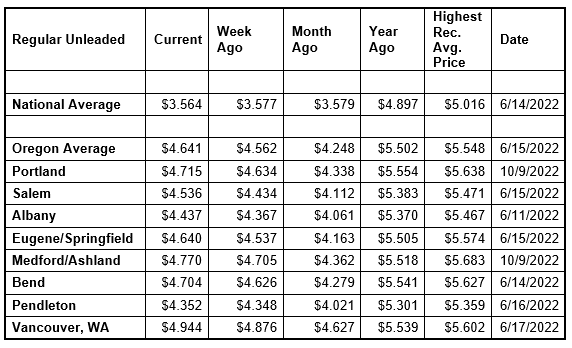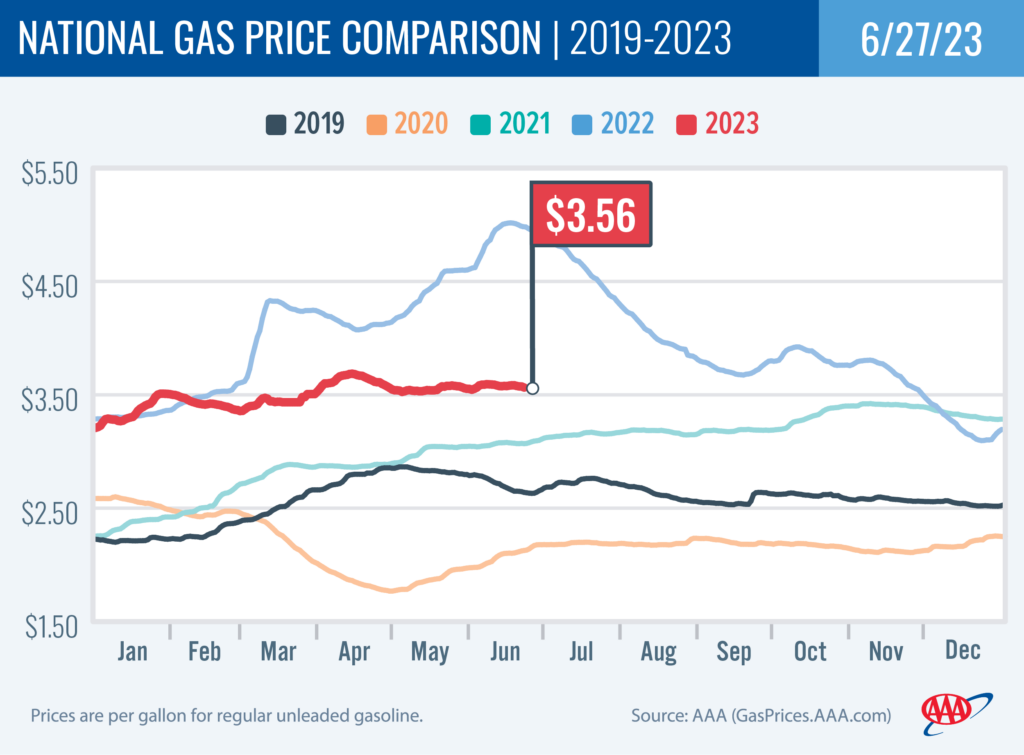PORTLAND, Ore., – While the national average has remained between $3.52 and $3.60 since the start of May, many states including Oregon have seen some large swings in prices during this time. This week, pump prices are up in 22 states, including Oregon, while prices have fallen in 28 states. For the week, the national average for regular dips a penny to $3.56. The Oregon average adds eight cents to $4.64. This is the fourth-largest weekly jump for a state in the nation.

Maintenance on the Olympic Pipeline has caused prices to rise in Oregon and Washington; in fact, Washington ($4.99) has the most expensive gas in the nation. Oregon is fourth most expensive.
AAA projects record travel for the Independence Day holiday, surpassing the previous record which was set in 2019 before the pandemic. AAA projects that nearly 51 million Americans including 587,000 Oregonians will travel. This is up 4.3% over last year, and up 3.7% compared to 2019.
The number of Americans traveling by car and by air are projected to be the highest on record. AAA expects 43.2 million people including 460,000 Oregonians will drive to their destinations. This is up more than 2% over last year. For air travel, AAA projects 4.17 million Americans including 84,000 Oregonians will fly to their destinations. This is up 11% compared to last year. Find details, graphics and tips for travelers in the AAA Independence Day news release.
Wholesale prices for gasoline shot up in Oregon and Washington because of scheduled work on BP’s Olympic pipeline. The Olympic pipeline runs along a 299-mile route from Blaine, Washington to Portland, Oregon, and transports gas, diesel, and jet fuel from four Puget Sound refineries. “The increases were passed on to consumers in the form of higher pump prices. There are some signs that drivers here will start to get some relief,” says Marie Dodds, public affairs director for AAA Oregon/Idaho. “Crude oil prices remaining in the upper $60s and low $70s helped keep pump prices from having more significant gains.”
Crude oil prices remain below $75 per barrel, despite the announcement in early June from the Organization of the Petroleum Exporting Countries and other major oil producers, including Russia, known collectively as OPEC+, that it would extend production cuts of more than 1 million b/d through 2024. OPEC+ first announced the production cuts at its April meeting and said the cuts would be in effect through 2023. OPEC+ pumps about 40% of the world’s crude oil.
Crude oil is trading around $69 today compared to $71 a week ago and $110 a year ago. In May, West Texas Intermediate ranged between about $63 and $77 per barrel. In April, WTI ranged between about $73 and $83. In March, WTI ranged between about $64 and $81 per barrel. In February, WTI ranged between about $73 and $80 per barrel. In January, WTI ranged between about $73 and $82 bbl. Crude reached recent highs of $123.70 on March 8, 2022, shortly after the Russian invasion of Ukraine, and $122.11 per barrel on June 8, 2022. The all-time high for WTI crude oil is $147.27 in July 2008.
Crude oil is the main ingredient in gasoline and diesel, so pump prices are impacted by crude prices on the global markets. On average, about 56% of what we pay for in a gallon of gasoline is for the price of crude oil, 20% is refining, 11% distribution and marketing, and 14% are taxes, according to the U.S. Energy Information Administration.
Demand for gasoline in the U.S. demand increased from 9.19 million b/d to 9.38 million b/d for the week ending June 16. This compares to 8.51 million b/d a year ago. Meanwhile, total domestic gasoline stocks rose by about .5 million barrels to 221.4 million bbl. With demand expected to increase for the Independence Day holiday, prices will likely fluctuate moderately through next week.
Quick stats
Oregon is one of 22 states and the District of Columbia with higher prices now than a week ago. Alaska (+18 cents) has the largest weekly jump. Arizona (-17 cents) has the largest weekly decrease.
Washington ($4.99) has the most expensive gas in the nation for the second week in a row. California ($4.84) is second, Hawaii ($4.73) is third, Oregon ($4.64) is fourth, Alaska ($4.26) is fifth, Nevada ($4.23) is sixth, and Utah ($4.00) is seventh. These are the seven states with averages at or above $4 a gallon, down from nine states last week. This week 42 states and the District of Columbia have averages in the $3-range. Only one state, Mississippi ($2.99) has an average in the $2 range this week.
The cheapest gas in the nation is in Mississippi ($2.99) and Louisiana ($3.10). For the 128th week in a row, no state has an average below $2 a gallon.
The difference between the most expensive and least expensive states is $2.00 this week, up from $1.90 a week ago.
Oregon is one of 17 states and the District of Columbia with higher prices now than a month ago. The national average is one cent less and the Oregon average is 39 cents more than a month ago. This is the largest monthly increase in the nation. Washington (+32 cents) has the second-largest monthly jump. Arizona (-58 cents) has the largest monthly drop.
All 50 states and the District of Columbia have lower prices now than a year ago. The national average is $1.33 less and the Oregon average is 86 cents less than a year ago. Indiana (-$1.58) has the largest yearly drop. Washington (-51 cents) has the smallest. Last year, pump prices rose rapidly after the Russian invasion of Ukraine.
West Coast
The West Coast region continues to have the most expensive pump prices in the nation with all seven states in the top 10. It’s typical for the West Coast to have six or seven states in the top 10 as this region tends to consistently have fairly tight supplies, consuming about as much gasoline as is produced. In addition, this region is located relatively far from parts of the country where oil drilling, production and refining occurs, so transportation costs are higher. And environmental programs in this region add to the cost of production, storage and distribution.
| Rank | Region | Price on 6/27/23 |
| 1 | Washington | $4.99 |
| 2 | California | $4.84 |
| 3 | Hawaii | $4.73 |
| 4 | Oregon | $4.64 |
| 5 | Alaska | $4.26 |
| 6 | Nevada | $4.23 |
| 7 | Utah | $4.00 |
| 8 | Idaho | $3.98 |
| 9 | Arizona | $3.97 |
| 10 | Illinois | $3.97 |
As mentioned above, Washington has the most expensive gas in the nation for the second week in a row. California, Hawaii, Oregon, Alaska and Nevada round out the top six. Arizona is ninth. Oregon is fourth for the third week in a row.
States in the West Coast region are seeing small to moderate changes on the week, just like every other state: Alaska (+18 cents), Arizona (-17 cents), Oregon (+8 cents), Washington (+7 cents), Nevada (-4 cents), California (-3 cents), and Hawaii (-7/10th of a cent).
The refinery utilization rate on the West Coast rose from 89.7% to 95.6% for the week ending June 16. This rate has ranged between about 73% to 95% in the last year. The latest national refinery utilization rate is 93.1%.
According to EIA’s latest weekly report, total gas stocks in the region decreased slightly from 29.57 million bbl. to 29.46 million bbl.
A higher refinery utilization rate can put downward pressure on pump prices, while a decrease in gasoline stocks can put upward pressure on pump prices.
Oil market dynamics
Crude oil prices declined last week, then rose on Monday as markets reacted to the fallout from the attempted insurrection in Russia and whether it would disrupt oil supplies from that country, which is one of the largest oil producers in the world. Crude prices have slipped again today on concerns of possible interest rate hikes in Europe. Additionally, the EIA reported that total domestic commercial crude inventories decreased by 3.8 million bbl to 463.3 million bbl last week.
At the close of Friday’s formal trading session, WTI lost 35 cents to settle at $69.16. At the close of Monday’s formal trading session, WTI added 21 cents to settle at $69.37. Today crude is trading around $68, compared to $69 a week ago. Crude prices are about $46 less than a year ago.
Drivers can find current gas prices along their route with the free AAA Mobile app for iPhone, iPad and Android. The app can also be used to map a route, find discounts, book a hotel and access AAA roadside assistance. Learn more at AAA.com/mobile.

Diesel
For the week, the national average slips a penny to $3.88 a gallon. The record high is $5.816 set on June 19, 2022. The Oregon average adds a penny to $4.43. The record high is $6.47 set on July 3, 2022. A year ago the national average for diesel was $5.79 and the Oregon average was $6.46.
Find current fuel prices at GasPrices.AAA.com.
AAA news releases, high resolution images, broadcast-quality video, fact sheets and podcasts are available on the AAA NewsRoom at NewsRoom.AAA.com.
Find local news releases at https://oregon.aaa.com/community/media/media-contacts.html
Fuel prices are updated daily at AAA’s Daily Fuel Gauge at AAA Gas Prices. For more info go www.AAA.com. AAA Oregon/Idaho provides more than 880,000 members with travel, insurance, financial and automotive-related services, and is an affiliate of AAA National, serving more than 63 million motorists in North America.

